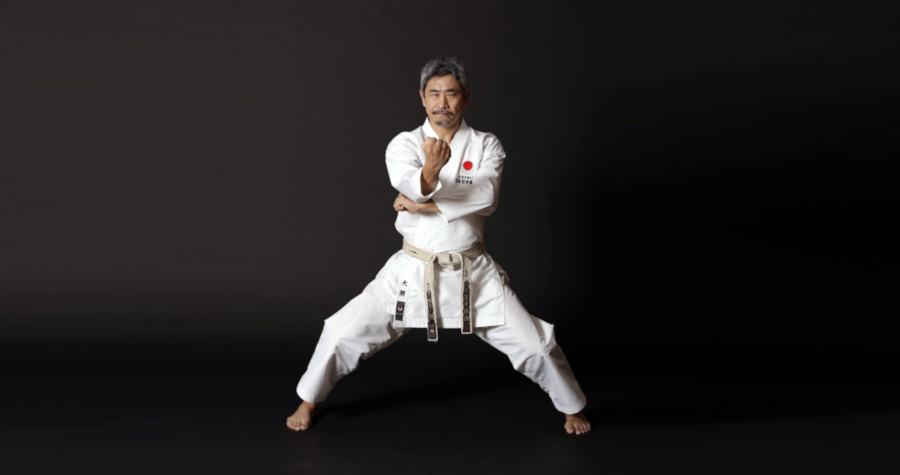Gasshuku CZ 2022 – JKA Karate Camp with 3 Japanese Grandmasters
The high art of transforming Kata techniques into Kumite applications – a Karate Gasshuku of the special class in Czech Republic, led by the masters Naka Tatsuya, Okuma Koichiro und Kurihara Kazuaki
Gasshuku – learning together!
A Gasshuku is not just a course in the technical sense. Rather, the commonality and the lively exchange between student and master is in the foreground. Therefore, in addition to the highest technical skills, historical and spiritual aspects also flow into the training, loosened up by the fine humor of the masters.
The JKA (Japan Karate Association) in Czech Republic has a solid base of motivated JKA karateka, which is why the legendary Japanese masters have enjoyed coming to this beautiful country for 17 years now. The excellent trainings, the familiar atmosphere and of course the good Czech beer attract countless karateka from other countries every year, which has made the Gasshuku CZ an internationally recognized and appreciated event.
Kihon, Kata, Kumite – the 3 pillars of Karate!
The principle of the three pillars of karate ran methodically through the entire course like a thread, woven by the skillful hands of the masters.
Kihon stands for the learning and correct execution of Karate techniques. In Kata, the techniques are brought together so that by connecting all parts of the body with timing and rhythm, a meaningful, harmonious sequence is created.
In the end, the constant practice of Kihon and Kata should lead to an efficient and effective use of techniques in Kumite.
No Kumite in Pandemic – Making a virtue out of necessity!
Due to Corona, no Kumite training could be held in the Honbu Dojo in Tokyo for two years. But how should the fighting abilities be maintained? – With intensive, thought-out and application-oriented Kata training! Kata or Kihon should not be practiced as an end in itself, for example to achieve the „perfect“ Kata, but always with the thought of the best possible application in combat. The Kata should be executed in a „flow“ and not degenerate into a rigid, choppy sequence of consecutive perfect individual techniques. According to the Kumite principle „go-no-sen“ the flowing transition from block to counterattack is also practiced in Kata. In addition, in many kata there are also applications of „sen-no-sen“, the simultaneous counterattack into an opponent’s attack.
Mostly Kata-Bunkai is practiced as an exact transfer of the Kata technique into the application – unfortunately often the question arises how realistic this form of interpretation is.
The fascinating thing during the Gasshuku CZ was the well thought-out transfer of the Kata sequences into realistic Kumite exercises, which we already intensively practiced at the beginning of the course through variations of the very first Kata „Taikyoku Shodan“.
Hip, Hip, Hip – from the middle springs the power!
Every karateka knows how important the use of the hips is and practices this from the beginning of his karate career. But what the 3 masters have delivered in this regard on the course is difficult to grasp and even more difficult to implement.
Naka sensei – the master of the fine blade
Naka draws an incredible knowledge from decades of study of all Budo arts. As a master of seamless transitions, he has taught us how to initiate a movement through proper hip control and seamlessly sequence other techniques. Small changes in stance, posture and angle of the force direction have a great effect – a masterful and probably unmatched example.
Okuma sensei – the master of 10,000 tekki per year
Okuma took his teacher Naka sensei as a role model and implemented the old masters‘ requirement to practice 10,000 tekki kata per year. It may sound absurd that a kata in the kiba-dachi stance trains the body perfectly for kumite, but Okuma sensei proved the opposite with incredibly impulsive demonstrations. The sideways stance makes it very difficult to use the hips, but after patient practice, the hips gain a suppleness that brings great advantages in speed and technique sequencing in fighting combinations. We have practiced with Okuma countless times the Tekki 1-3 in different versions: At the stand only with arms or single movements several times in a row, then whole kata and in between the applications. Okuma sensei is an incredible role model of snappy hip action and impulsive forward movement. And apart from the technical brilliance, every training is rounded off by humanity and humor!
Kurihara sensei – the master of dynamics and power
Kurihara sensei radiates an aura of good-naturedness and calm, but when he fires off a technique, the whole hall vibrates. Using Kata Sochin as an example, we practiced stable stance, smooth flowing movements and quick changes of direction. Kurihara sensei is the embodiment of Sochin come to life – which means „strength and calmness“. My eyes did notice the incredibly strong use of the hips and the snapping kime of the arm techniques, but unfortunately I lacked the skill to implement them. Kata skill at this level makes a karateka a feared opponent in combat (Saying of Okuma). No wonder Kurihara sensei was extremely successful in both disciplines!
Karateka – an international family!
Although a Gasshuku is mainly about karate, it is also about the family get-together of like-minded people. You get to know new friends, meet old acquaintances and hear interesting stories. Of course, the one or other beer after the training may not be missing. All in all, a Gasshuku is an enriching experience for every karateka, which often lasts for years.
Especially the Gasshuku in the Czech Republic is characterized by hospitality and karate passion. Therefore, it is clear for me:
I’ll be back …







 Franz Peischl
Franz Peischl Franz Peischl
Franz Peischl 
 Okuma Koichiro
Okuma Koichiro 
 Franz Peischl
Franz Peischl Okuma Koichiro
Okuma Koichiro